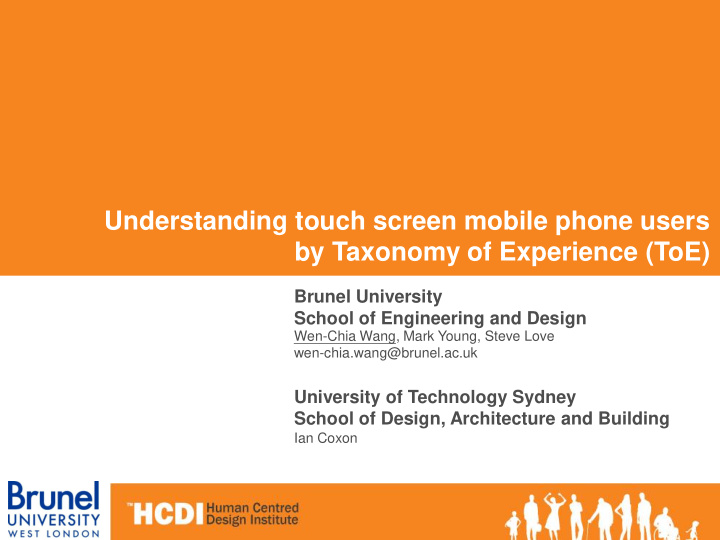



Understanding touch screen mobile phone users by Taxonomy of Experience (ToE) Brunel University School of Engineering and Design Wen-Chia Wang, Mark Young, Steve Love wen-chia.wang@brunel.ac.uk University of Technology Sydney School of Design, Architecture and Building Ian Coxon
Purpose • Introduce the methodology of Taxonomy of Experience (ToE) & its analysis process of SEEing • To understand touch screen mobile phone users by ToE-SEEing
Definition of user experience • user experience is beyond usefulness and usability of a product • it might be affected by the user’s internal state, the context and perceptions of the product • it is subjective, highly situated and dynamic in nature The importance of experiencing a product is ‘the entire experience, from when I first hear about the product, to purchasing it, to opening the box, to getting it running, to getting service, to maintaining it, to upgrading it’ Norman, 2000
Previous studies • Experimental pilots (Isomursu, 2008) user’s attitudes and expectations • Emotion (Hole & williams, 2008) emotion sampling • Concept of the object (al-Azzawi, Frohlich & Wilson, 2008) multiple card sorting • Judgment of the product (Karapanos & Martens, 2008) repertory grids Diary, focus groups, surveys, competitive analysis…and so forth
Taxonomy of Experience (ToE) • to understand the user’s experience with a product via analysis of their verbal commentary to find the deep meanings hidden from the verbal commentary • based on philosophy, methodology and design theory • to understand an experience by four aspects
SEEing-the analysis method of ToE • uncover an understanding of the user experience through qualitative analysis • the term of SEEing attempts to differentiate from the processes of thinking, but still associates with the thinking processes
ToE-SEEing process Step 1: Gathering data and establishing structures researchers have to immerse themselves in the experience completely, collect the information for writing the descriptions for later steps (e.g. images, sounds, samples) Step 2: Descriptive narratives transform the data collected in Step1 into a textual format for analysis Step 3: Sorting fragments into themes to sort fragments into meta-themes (somatic, affective, cognitive and contextual factors) & sub-themes (senses, positive-negative affect, internal-externalised cognition, contextual categories) Step 4: Developing meaning(s) to find the deeper meanings behind the fragment to ‘tease out’ the text into different meanings to accept all ‘possible’ meanings that are contained within the fragment
ToE-SEEing process Step 5: Essential elements to filter out the less important meanings if the element is essential to the experience, or the experience might be different without the element. Step 6: Super-ordinary elements to distil the super-ordinary essence of the experience, i.e. the unexpected, novel and hidden aspects of the experience to isolate those elements of the experience that might not have been seen as an important part of the original design this process searches for the surprising elements, the unintended impacts of the experience. Step 7: Weighting of super-ordinary elements to weight which super- ordinary elements are more ‘powerful’ of the essential elements of the experience by Likert rating 1-7
ToE-SEEing process Step 8: Super-ordinary summary words to use word metaphors to synthesise ‘what is the collective meaning behind these elements’? for example, the super- ordinary element of ‘no risk means no fun’, could essentially be a statement about ‘freedom to enjoy danger’ Step 9: Summary word descriptions to summarise the Step 6-8. to present the understanding of the experience to someone who does not understand the meaning of the super-ordinary words by 1-2 narrative paragraphs
Experiment design Participants: Twelve participants were recruited from a British University 6-current use a touch screen mobile phone 6-current use a 12 keypad mobile phone Instrument: Vodafone 541 Task: 5 minutes free trial
Result Understanding-from the head It is important to see that the ‘graphic icon and its title are consistent, and represent the function clearly’. Clear feedback is given confirmation whether or not the operation was successful. It is essential to show instructions for unique features of the phone, maybe to demonstrate how to operate the feature, or to make it easy to get ‘help’ information. Sensitivity of the touch screen is crucial, and should fit the user’s pace when operating the phone. The user would like to dominate, to trust the phone, and to fully understand the operation process before using the phone.
Result Experienced and familiar-from daily life and history The way to operate the scroll bar on Vodafone 541 should be the same as using the scroll bar on a computer. From previous experience of using a mobile phone with a 12 keypad, it would be good to see that the icon becomes highlighted when browsing the icon on the menu. It will help to reduce mistakes if the phone can highlight what the mistake was, to detect the failed task automatically, and then provide help and instructions to complete the task correctly before the user has to ask for help.
Result Freedom-from the operation The phone should provide links between different functions, rather than having to go to the menu to execute another function. The size of the phone provides the freedom for the user to carry it all the time, and allowing the user to hold the phone in the hand easily without worrying that the phone might slip from the grasp. The other super-ordinary elements: ‘specific’, ‘share’, ‘intimacy’, ‘comfortable’, ‘enjoyment’, ‘flexible’, and ‘logic’
Discussion • to categorise the raw meaning of an experience to find the meanings behind the user’s commentary • to sort the importance of the experiences • provides an overview of the user’s experience and describes whether it is the user’s previous experience or the experience that was produced when trialing the object • elements not only reflect the user’s expectation of Vodafone 541, but also highlight the components that the user cares about most • to follow design guidelines and to understand user experience before ‘DESIGN’
Thanks for your attention E-mail contact: mepgwcw@brunel.ac.uk any questions?
Recommend
More recommend